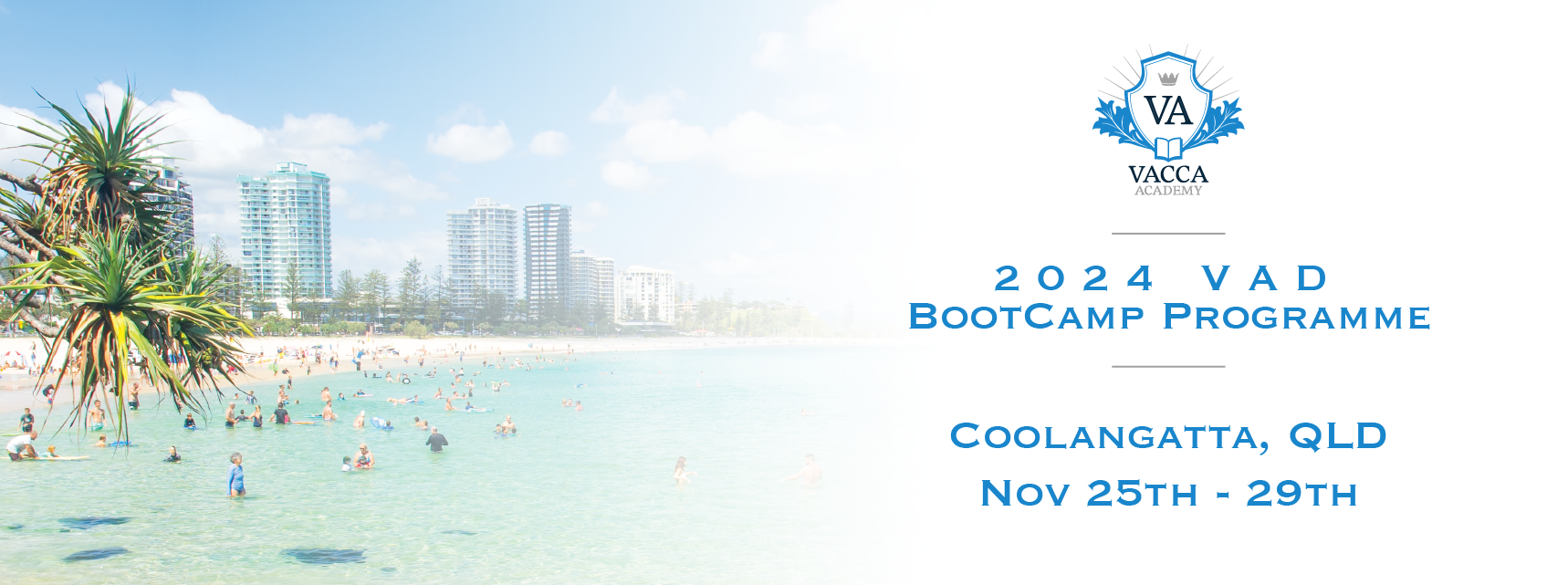
Deepening our understandings of safe VAD practices
Join the 2024 Vacuum-Assisted Delivery Bootcamp for advanced accredited
obstetrics training designed to empower the next generation of obstetric leaders.
Earn CME points, enhance your skills, and make valuable network connections.
Nov 25th | Please join us at the Welcome Reception to meet your fellow participants and facilitators for Drinks & canapés
Cost: Included in registration
Dates & Location
• November 25th to November 29th
• Twin Towns Club & Resort, Coolangatta QLD Australia
Bootcamp Programme
At the 2024 VAD Bootcamp we will review and build upon your current knowledge of vacuum delivery principles, tackling the nuances that clinicians often face in practice. The Bootcamp will include extended opportunities for simulation work, with expert-led technique correction in the VAD 5-Steps procedure. You’ll also benefit from advanced simulation scenarios designed to improve your decision-making and emergency management skills.
This four days of training will not only enhance your technical abilities but also provide a valuable opportunity to connect with other O&G professionals who share your commitment to birth safety.
Bootcamp Welcome drinks meet and greet
We look forward to seeing you at the Welcome Reception, a great opportunity to meet participants and facilitators.
Time: 5:30pm, Monday 25th November, 2024
Venue: Room TBA
Dress: Semi-casual
Included: Drinks & canapés
Cost: Included with your registration
The Fundamentals of Safe Vacuum Delivery
7 CME Points
Delivery: Online
Duration: 7 Hours (6mo access)
This online fundamentals course equips participants with the essential knowledge for successful vacuum-assisted delivery. You will understand the obstetric conditions for the safe use of the vacuum extractor, and learn the 5-Step VaccaTechnique™. Additionally, there will be an opportunity to test your understanding before attending the hands-on practical workshop.
Objectives:
- Learn the key concepts of vacuum-assisted delivery.
- Understand the obstetric situations where the vacuum extractor can and cannot be used safely.
- Learn the 5-Step VaccaTechnique™ for effective and safe vacuum deliveries.
- Prepare for the practical workshop by testing your knowledge.
Learning Outcomes:
- Define the principles of vacuum-assisted delivery.
- Locate and describe the flexion point.
- Assess patient suitability for a vacuum-assisted delivery procedure.
- Demonstrate a thorough understanding of safety measures and procedural limits of VAD.
- Describe the 5 key steps of vacuum-assisted deliveries.
- Recognise early warning signs of subgaleal haemorrhage.
- Explain preventative measures and management of subgaleal haemorrhage.
Class Outline:
Lesson One: Introduction to the class, instructors, and usage guidelines
- Concepts: Overview of the course, Introduction to Aldo Vacca, Meet Belinda Vacca, Class completion guidelines, Course structure, Basics of vacuum delivery.
Lesson Two: Understanding technical principles, maneuverability, and vacuum cup selection
- Concepts: Assisted birth methods, Flexion point identification, Head positioning & diameters, Cup placement, Pelvic axis & axis traction.
Lesson Three: Step-by-step guide to vacuum delivery, focusing on technique and procedural steps
- Concepts: Flexion point location, Cup insertion calculation, Cup selection and maneuvering, Proper traction techniques, Pelvic floor phase, Cup detachment prevention.
Lesson Four: Obstetric conditions for the safe or unsafe use of the vacuum extractor
- Concepts: Operator experience, Safety measures before, during, and after delivery, Procedural limits, The 3+3 rule, Subgaleal hemorrhage prevention, Traction technique, Patient selection.
Lesson Five: Revision for the final certificate assessment
- Concepts: Contraindications, Safety protocols, Procedural limits, Prevention of subgaleal hemorrhage, Key principles, Correct procedure review, Further learning opportunities.
Face-2-Face Fundamentals of VAD
CME Pending
Delivery: Face-2-Face
Duration: 1/2 Day
Building on the online module, this face-to-face workshop offers participants the chance to explore the principles of vacuum-assisted delivery in greater depth and build muscle memory for the key mechanics of the 5-Steps technique. Through practical exercises and case discussions, attendees will gain a deeper, more holistic understanding of safe delivery practices. This hands-on experience is designed to bridge theoretical knowledge with real-world application.
Objectives:
- Understand the mechanics behind vacuum-assisted delivery.
- Refine skills in identifying the flexion point on the fetal head.
- Refine skills in the method of traction.
- Build confidence in patient selection and safety protocols.
- Build confidence in troubleshooting and decision-making in practice.
Learning Outcomes:
- Demonstrate a solid understanding of the role of vacuum-assisted delivery within the broader context of birthing practices.
- Understand the critical importance of accurate cup placement over the flexion point.
- Accurately identify and locate the flexion point on the fetal head.
- Grasp the significance of the progressive direction of travel through the descent and pelvic floor phases and its influence on the direction of traction.
- Confidently implement procedural limits and safety measures during delivery.
- Select and manage patients appropriately for vacuum-assisted delivery cases.
Course Outline:
Module 1: Welcome & Introductions
- Overview of the workshop and its objectives.
- Introductions and expectations setting.
Module 2: Contextualising VAD
- Overview of the place of vacuum-assisted delivery in the wider suite of birthing practices.
- Conceptualising a classic clinical case for VAD.
- The value of ‘trialling’ VAD.
- 5-Step VaccaTechnique review.
Module 3: Flexion Point in Practice
- Importance of accurate cup placement for safe delivery.
- Practical exercise in understanding how flexion point placement eases descent.
- Practical exercises to perfect the location of the flexion point on the fetal head.
- Opportunity for discussion and questions related to the flexion point.
Short Break: 15 minutes
Module 4: Traction in Practice
- Practical exercises in understanding the mechanics involved in correct method of traction.
- Practical exercises to perfect the direction and force of traction.
- Opportunity for discussion and questions related to method of traction.
Module 5: Troubleshooting
- Overview of how to mitigate cup detachment.
- Understanding procedural limits to ensure safe and effective delivery.
- Review and discussion of patient selection.
- Consideration of factors within operator control.
- Case studies exercise.
Module 6: Group Review
- Group review and discussion of key concepts that influence success and safety in vacuum delivery.
The Vacca Steps Skills Workshop
4 CME Points
Delivery: Face-2-Face
Duration: 1/2 Day
Acquire the hands-on technical skills for safe vacuum-assisted delivery in this practical workshop, using specialized medical manikins under the guidance of a master in the Vacca 5-Step technique.
Objectives:
- Master the practical steps of vacuum-assisted delivery.
- Review the Vacca 5-Step Technique in theory.
- Learn to apply the Vacca 5-Step Technique for various fetal positions.
- Gain experience through simulations and live feedback.
Learning Outcomes:
- Demonstrate the ability to accurately locate and attach the cup over the flexion point.
- Perform OA, OT, and OP vacuum-assisted deliveries in a simulated environment.
- Differentiate between the descent and pelvic floor phases during delivery.
- Recognize and follow procedural limits in practice to ensure safe and effective outcomes.
Workshop Outline:
Module 1: Welcome & Introductions
- Introduction to the workshop and a recap on the Fundamentals of Safe Vacuum Delivery.
Module 2: Practical Demonstration
- Learn the steps and principles of the vacuum delivery procedure.
Short Break: 15 minutes
Module 3: One-to-One Practical Tuition
- Practice the step-by-step procedure of vacuum delivery and familiarize yourself with the mechanics and common procedural steps for all vacuum deliveries with specialized VAD simulation manikins.
Module 4: Practical Assessment
- Perform three successful simulations in OA, OT, and OP positions respectively.
Module 5: Close & Discussion
- Recap with key takeaways, and opportunity to address any remaining questions.
Advanced Simulation Scenario Training
CME Pending
Delivery: Face to Face
Duration: 90 minutes
This advanced simulation course offers obstetrics registrars and midwives the chance to experience advanced scenarios designed to challenge decision-making and emergency management skills. Participants will refine their expertise in working as a team to manage vacuum-assisted deliveries, focusing on maintaining communication and situational awareness. The course is ideal for those seeking to deepen their skills in high-pressure environments, with a strong emphasis on preventing complications like subgaleal haemorrhage.
Objectives:
- Strengthen multidisciplinary teamwork in the delivery suite.
- Recognise and respond to early signs of failed instrumental birth.
- Document procedures and complications effectively.
- Document procedures and complications effectively using the appropriate forms.
- Minimize risks of subgaleal haemorrhage during vacuum-assisted deliveries.
Learning Outcomes:
- Successfully manage vacuum-assisted deliveries through multidisciplinary teamwork.
- Enhance situational awareness during vacuum-assisted deliveries.
- Identify and respond to warning signs, such as vacuum pop-off and poor fetal descent.
- Confidently use documentation tools to capture procedures and outcomes.
- Apply safety protocols to minimise complications, including subgaleal haemorrhage.
- Increased confidence in decision-making during complex delivery scenarios.
Course Outline:
Module 1: Welcome & Introductions
- Overview of the simulation and its objectives.
- Team introductions and expectations setting.
Module 2: Vacuum-Assisted Delivery Management Simulation
- Hands-on simulation of two vacuum-assisted deliveries.
- Team coordination and communication.
- Managing contractions, timing pulls, and successful delivery.
- Monitoring for procedural limits.
- Corrective feedback.
Module 3: Debriefing and Feedback
- Group discussion on teamwork, communication, and technical execution.
- Focus on what went well and areas for improvement.
Module 4: Case Study Discussions
- Review of real-life cases of subgaleal haemorrhage and failed vacuum deliveries.
- Troubleshooting and lessons learned from documented cases.
Extended Time on our Simulation Training Models
CME Pending
Delivery: Face-2-Face
Duration: Open
OPEN PRAC provides extended time on simulation models, guided by experienced instructors, allowing participants to hone their skills before performing vacuum-assisted deliveries in real-world settings. These practical sessions are invaluable for those seeking to build confidence and proficiency in the delivery suite, offering crucial practice time before facing the demands of the labor ward.
Objectives:
- Provide extended practice time on simulation models to refine technique.
- Improve technique with expert guidance and feedback.
- Enhance confidence and build muscle memory in correct vacuum technique.
- Bridge the gap between training and real-world application in the labor ward.
- Strengthen procedural skills through repetitive, focused practice.
Learning Outcomes:
- Improved proficiency in the Vacca Steps technique.
- Identify areas of personal improvement and address them through guided practice.
- Master the ability to manage procedural steps with minimal errors.
- Gain confidence and readiness for performing vacuum-assisted deliveries in clinical practice.
Open Prac Outline:
Welcome & Introductions
- Overview of the session and its objectives.
- Introductions and expectations setting.
Extended Practice: Independent & Guided Learning
- Hands-on practice with simulation models.
- Instructors provide real-time guidance and corrective feedback.
- Focus on the Vacca Steps technique.
- Practice identifying and addressing common complications.
- Instructors demonstrate corrective techniques for errors made during simulation.
Review and Feedback
- Discussion on skills gained and areas for improvement.
- Instructors provide individualised feedback for continued development.
Vacuum-assisted Birth in
Maternal Lateral Posture versus Lithotomy
Delivery: Live Webinar
Duration: 2 Hours
We are pleased to invite you to a special live webinar where Dr. Marcos Javier Cuerva will present his latest research: Vacuum-Assisted Birth in Maternal Lateral Posture versus Lithotomy: A Simulation Study. This insightful study, recently published in the European Journal of Obstetrics and Gynecology, explores the feasibility and accuracy of performing vacuum-assisted births in a maternal lateral posture compared to the traditional lithotomy position.
In this session, Dr. Cuerva will walk us through the methodology, key findings, and potential implications for clinical practice. His research, conducted with both experienced obstetricians and medical students, offers valuable perspectives on alternative maternal postures that could enhance patient comfort and potentially improve delivery outcomes.
Don’t miss this opportunity to engage with leading experts, ask questions, and gain a deeper understanding of this innovative approach to vacuum-assisted deliveries.
A Focus on Sub-Galeal Haemorrhage
CME Pending
Delivery: Face 2 face or via webinar (to be confirmed)
Duration: 2 Hours
During this presentation we focus on the prevention, recognition, and management of Subgaleal Hemorrhage (SGH) during vacuum-assisted delivery (VAD) in the context of clinical quality and guidelines (Q&G). Participants will gain an enhanced awareness of how to mitigate against SGH, reliably identify the condition and respond effectively when present, ensuring optimal safety.
Objectives:
- Understand the critical anatomy and risk factors associated with subgaleal haemorrhage (SGH).
- Understand how adhering to clinical guidelines can reduce SGH incidence during VAD.
- Recognise and manage early signs of SGH and other complications.
- Identify practical strategies for quality improvement in the delivery room to prevent SGH.
Learning Outcomes:
- Demonstrate a comprehensive understanding of the anatomy involved in SGH.
- Identify key risk factors that contribute to the development of SGH during VAD.
- Explain how following clinical guidelines can minimize the risk of SGH.
- Apply clinical guidelines effectively to reduce the incidence of SGH during VAD.
- Recognize the early signs and symptoms of SGH in newborns.
- Implement appropriate management strategies to address SGH and other related complications promptly.
- Develop and propose practical strategies for quality improvement in the delivery room.
- Evaluate the effectiveness of implemented strategies in preventing SGH.
Course Outline:
Module 1: Welcome & Introductions
- Overview of the workshop and its objectives.
Module 2: Detailed Overview of Sub-Galeal Haemorrhage
- Detailed explanation of cranial anatomy, highlighting areas prone to SGH.
Module 3: Risk Factors for SGH in Vacuum-Assisted Delivery
- Clinical case factors that increase the likelihood of SGH developing.
- Procedural factors that increase the likelihood of SGH developing.
- Post procedural factors that influence the morbidity/mortality of SGH.
Module 4: Best Practice SGH Risk Mitigation during VAD procedure
- Appropriate patient selection and safety before the procedure.
- The relevance of accurate cup placement and proper technique.
- The critical importance of adhering to procedural limits.
Module 5: Recognition and Management of SGH
- Identifying early warning signs.
- Immediate Response Protocols if SGH is suspected, including neonatal consultation and care.
Module 6: Case Studies
- Review of SGH incidents and discussion of what could have been done to improve the outcome of the cases.
Module 7: Group Review
- Group review and discussion of best practice mitigation and management of sub-galeal haemorrhage in vacuum delivery.
Debrief Q & A - Tea & Coffee
We'll wrap up the Vacca Bootcamp with a 2-hour Discussion, Q&A, and Debrief session. This is your chance to engage with our trainers and fellow delegates, have lasting questions answered by an expert, and reflect on the week’s learnings. The session will be followed by morning tea with our trainers.
Accreditation Information
Our program is accredited for a total of 11 CME hours.
Participants will earn these CME points upon successful completion of the practical and final assessments. After finishing the course, a Certificate of Completion will be issued, which may be required for your professional accreditation.
Meet Your Trainers

Belinda Vacca
Midwife & Master Trainer
Bio: Belinda is a master trainer in vacuum-assisted delivery (VAD) and has been a practicing midwife for 23 years. As the daughter of the late Dr. Aldo Vacca, she has had the unique opportunity to learn from one of the foremost experts in VAD.
Vacuum-assisted delivery has been a central part of Belinda’s life, and she is dedicated to continuing her father’s legacy by delivering his high-quality 5-Steps training program both in Australia and internationally through the Vacca Academy.

Dr. Paul Howat
Director for Women’s and Children’s Services
Bio: Paul is an obstetrician and gynaecologist graduating from University of Melbourne in 1986 and received his fellowship in 1996. He has recently semi-retired after 9 years as Divisional Director of Women’s and Children’s Services at Northern Health in Melbourne, and another 10 years prior to that as Clinical Director of O&G in Cairns in Queensland. He has held clinical associate professor roles at James Cook University and the University of Melbourne. He completed the Masters of Surgical Education in 2022 and is furthering his interest in education now he has stepped down from leadership and management roles. He is currently undertaking a History of Medicine Diploma at the Worshipful Society of Apothecaries.

Dr. Marcos J. Cuerva
Specialist in Obstetrics and Gynecology, La Paz University Hospital - Madrid
Bio: Marcos J. Cuerva is a specialist in obstetrics and gynecology, working in the birth unit at the Hospital Universitario la Paz in Madrid.
His career has been dedicated to clinical practice, teaching, and research. He serves as a professor of obstetrics and gynecology at the Universidad Autónoma de Madrid and the Universidad Alfonso X el Sabio. Additionally, he supervises resident training and actively promotes education through the development and implementation of simulation courses.
He is a member of the Spanish Group for Obstetric Safety (GESO), where he collaborates to improve medical care practices. His research interests include non-invasive fetal monitoring, operative obstetrics, and advanced obstetric techniques.
Frequently Asked Questions
Q: What is the accreditation process for CME points?
A: Participants must complete all required courses and webinars to earn the full CME points. Certificates will be provided upon completion.
Q: Do I need to complete the theory course before the practical skills session?
A: Yes, you must complete the online course, The Fundamentals of Safe Vacuum Delivery, before attending the workshop. The online class starts on October 1st and must be completed prior to the in-person Bootcamp.
Q: What is the cancellation policy?
A: Full refunds are available for cancellations made before October 15, 2024. After this date, a 50% refund will be provided.
Q: Is accommodation included in my registration?
A: No, accommodation is not provided. However, guests attending the VAD Bootcamp can enjoy a 10% discount off the Daily Accommodation Rate at The Sebel Twin Towns and Mantra Twin Towns.
Q: How do I book my guest discount accommodation?
A:
The Sebel Twin Towns and Mantra Twin Towns are pleased to offer all Vacca Academy guests, attending from November 25th to November 29th, 2024, a 10% discount off the Daily Accommodation Rate.
You will receive accommodation booking details in your confirmation email upon completion of registration.
What Delegates are Saying
Connect with our Training Liaison
We’re here to help!
Reach out anytime for more information and support with your training journey.

Teagan Berger
Academy Training Coordinator
+61 422 641 056teagan.berger@vaccaacademy.com
Registrations
Fees:
Early Bird: $1,600 | Regular: $1,900 (AUD Inc. GST)
(includes access to all courses and webinars)
*Limited bursaries available
Deadline: Register by November 18, 2024, to secure your spot. The early bird discount is available until September 30, 2024.
Accommodation Offer:
Guests attending the VAD Bootcamp from November 25th to November 29th, 2024, can enjoy a 10% discount on the Daily Accommodation Rate at The Sebel Twin Towns and Mantra Twin Towns. You will receive accommodation booking details in your confirmation email upon completion of registration. *Please note that the course fee does not include accommodation.